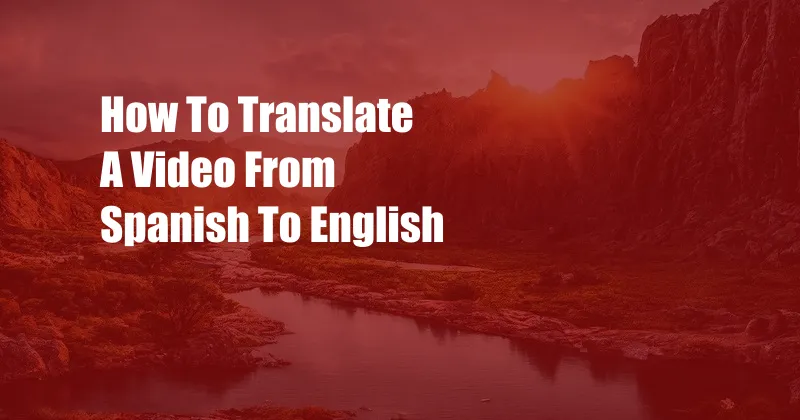
How to Seamlessly Translate a Video from Spanish to English: A Comprehensive Guide
In today’s globalized world, where communication transcends borders, translating content to bridge language barriers has become essential. Videos, a powerful medium for conveying information and engaging audiences, are no exception. If you possess a Spanish video and need to make it accessible to English-speaking viewers, this comprehensive guide will empower you with the knowledge and techniques to achieve a seamless translation.
Understanding Video Translation: A Bridge Between Languages
Video translation involves converting the audio content of a video from one language to another while maintaining its visual integrity. This intricate process demands expertise in both languages and an understanding of cultural nuances to convey the intended message accurately. By translating videos, you unlock their potential to reach a broader audience and amplify your message’s impact.
Subtitle vs. Dubbing: Choosing the Right Approach
There are two primary methods for translating videos: subtitling and dubbing. Subtitling displays the translated text on the screen, while dubbing replaces the original audio with a voiceover in the target language. Each approach has its advantages and is suitable for specific situations.
Subtitling: Preserving the Original Voice
Subtitles discreetly convey the translation below the video’s frame, allowing viewers to read and listen to the original audio simultaneously. This method is less intrusive, preserves the actors’ performances, and is often preferred for documentaries, news reports, and educational videos.
Dubbing: Creating a Simpler Viewing Experience
Dubbing provides a more immersive experience by replacing the original audio with a synchronized voiceover. It’s often used for feature films, television shows, and commercials, as it eliminates the need for reading and allows viewers to focus solely on the visuals. However, dubbing can alter the actors’ intended performances and may require a larger budget.
Steps for Translating a Video from Spanish to English
Now that you have a clear understanding of the available translation methods, let’s dive into the detailed steps involved in translating a video from Spanish to English:
-
Select a Translation Method: Consider the type of video and your target audience to determine whether subtitling or dubbing is more appropriate.
-
Hire a Professional Translator: Engage a reputable translation agency or freelance translator with expertise in both Spanish and English. They will ensure accurate and culturally sensitive translations.
-
Create a Transcript: Obtain a transcript of the original Spanish audio. This will serve as the basis for the translation.
-
Translate the Transcript: The translator will meticulously translate the transcript, capturing the meaning and nuances of the original dialogue.
-
Incorporate the Translation: For subtitling, the translated text will be added to the video using subtitling software. For dubbing, the voiceover will be recorded and synchronized with the video footage.
Tips for Effective Video Translation
To achieve a high-quality video translation, consider these expert tips:
-
Prioritize Accuracy: Ensure the translation conveys the precise meaning of the original content without altering its intent or message.
-
Match the Tone and Style: The translation should align with the tone and style of the original video, capturing the speaker’s emotions and intended message.
-
Consider Cultural Context: Be mindful of cultural differences and adapt the translation to resonate with the target audience’s cultural background.
-
Proofread Carefully: Before finalizing the translation, thoroughly proofread it to eliminate any errors in grammar, spelling, or punctuation.
FAQs on Spanish to English Video Translation
Q: Can I translate a video on my own using online tools?
A: While online translation tools can provide basic translations, they may not capture the intricacies and nuances of professional translation. For optimal accuracy and cultural sensitivity, it’s recommended to engage a qualified translator.
Q: How long does it typically take to translate a video?
A: The translation time varies depending on the video’s length and complexity. However, a professional translator can provide an estimated timeline based on the specific requirements.
Q: What is the cost of video translation?
A: The cost of video translation varies depending on the factors mentioned above, as well as the translator’s experience and the chosen method (subtitling or dubbing).
Conclusion
Translating a video from Spanish to English can unlock its potential to reach a wider audience and amplify your message. By carefully considering the translation method, engaging a professional translator, and following the detailed steps outlined in this guide, you can achieve a seamless translation that preserves the video’s integrity and effectively conveys its intended message.
Are you ready to bridge the language barriers and connect with a global audience? Embark on this journey of video translation today!